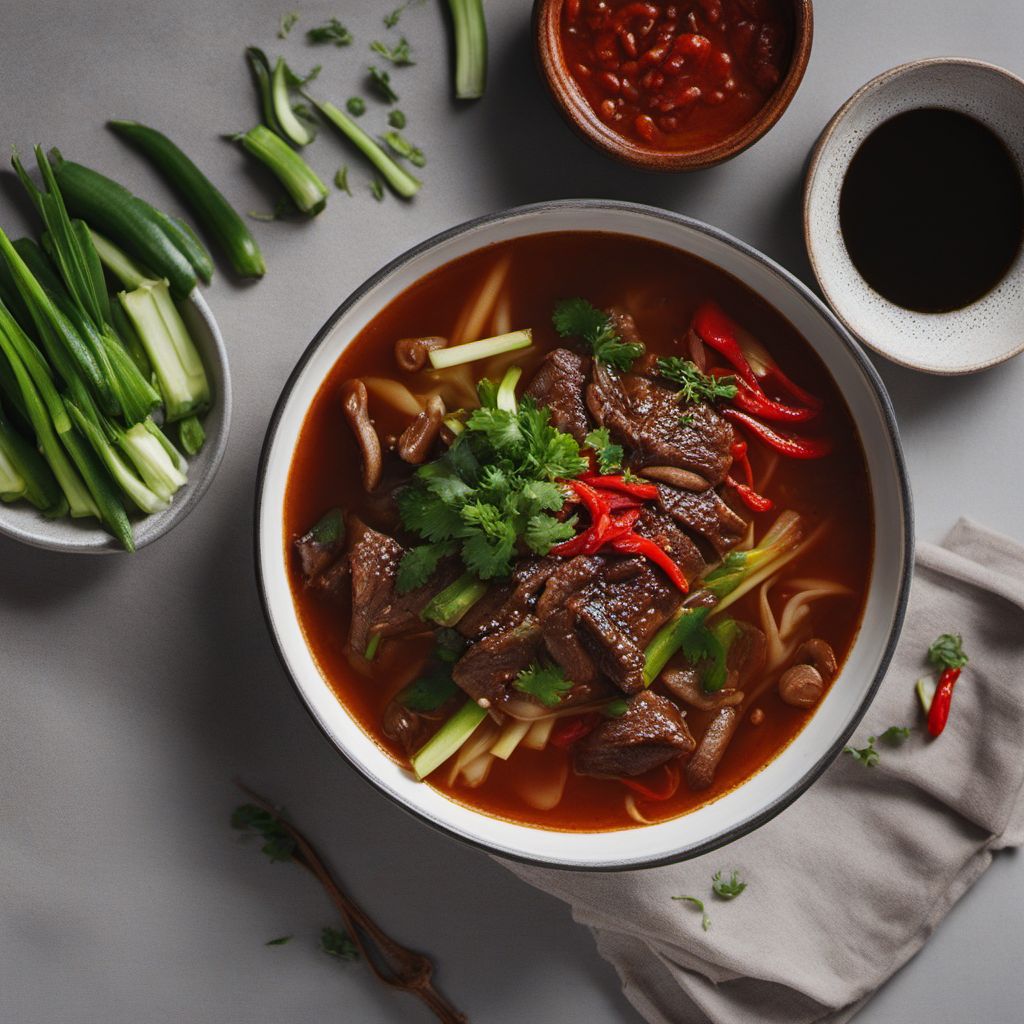
Recipe
Bosintang - Korean Spicy Beef Soup
Fiery Beef Delight: A Spicy Korean Soup to Warm Your Soul
4.2 out of 5
Bosintang is a traditional Korean soup known for its bold flavors and spicy kick. This hearty dish is made with tender beef, an array of vegetables, and a rich broth that will leave you craving for more.
Metadata
Preparation time
20 minutes
Cooking time
1 hour 10 minutes
Total time
1 hour 30 minutes
Yields
4 servings
Preparation difficulty
Medium
Suitable for
Gluten-free, Dairy-free, Low-carb, High-protein, Paleo
Allergens
Soy
Not suitable for
Vegan, Vegetarian
Ingredients
-
500g (1.1 lb) beef brisket, thinly sliced 500g (1.1 lb) beef brisket, thinly sliced
-
1 onion, sliced 1 onion, sliced
-
4 cloves garlic, minced 4 cloves garlic, minced
-
2 green onions, chopped 2 green onions, chopped
-
1 red chili pepper, sliced 1 red chili pepper, sliced
-
1 green chili pepper, sliced 1 green chili pepper, sliced
-
1 small zucchini, sliced 1 small zucchini, sliced
-
100g (3.5 oz) mushrooms, sliced 100g (3.5 oz) mushrooms, sliced
-
1 tablespoon sesame oil 1 tablespoon sesame oil
-
2 tablespoons soy sauce 2 tablespoons soy sauce
-
1 tablespoon gochujang (Korean chili paste) 1 tablespoon gochujang (Korean chili paste)
-
1 tablespoon gochugaru (Korean chili flakes) 1 tablespoon gochugaru (Korean chili flakes)
-
1 tablespoon doenjang (Korean soybean paste) 1 tablespoon doenjang (Korean soybean paste)
-
1 tablespoon fish sauce 1 tablespoon fish sauce
-
1 tablespoon sugar 1 tablespoon sugar
-
1 teaspoon black pepper 1 teaspoon black pepper
-
1 teaspoon salt 1 teaspoon salt
-
1.5 liters (6 cups) beef broth 1.5 liters (6 cups) beef broth
-
2 cups water 2 cups water
Nutrition
- Calories (kcal / KJ): 350 kcal / 1465 KJ
- Fat (total, saturated): 15g, 4g
- Carbohydrates (total, sugars): 10g, 4g
- Protein: 40g
- Fiber: 3g
- Salt: 2g
Preparation
-
1.In a large pot, heat sesame oil over medium heat. Add minced garlic and sliced onion, and sauté until fragrant.
-
2.Add the beef slices to the pot and cook until browned.
-
3.Stir in gochujang, gochugaru, and doenjang, and cook for another 2 minutes.
-
4.Pour in the beef broth and water, and bring to a boil.
-
5.Reduce the heat to low and simmer for 1 hour, or until the beef is tender.
-
6.Add the sliced zucchini, mushrooms, green onions, red chili pepper, green chili pepper, soy sauce, fish sauce, sugar, salt, and black pepper. Simmer for an additional 10 minutes.
-
7.Serve hot and garnish with additional green onions and chili flakes, if desired.
Treat your ingredients with care...
- Beef — For the best results, choose a tender cut of beef, such as brisket or ribeye, and slice it thinly against the grain to ensure tenderness.
- Gochujang — Adjust the amount of gochujang according to your spice preference. Add more for a spicier soup or reduce the amount for a milder flavor.
- Gochugaru — If you can't find gochugaru, you can substitute it with regular chili flakes, but the flavor may differ slightly.
- Doenjang — If you don't have doenjang, you can substitute it with miso paste for a similar umami flavor.
Tips & Tricks
- For a richer flavor, you can add a small piece of beef bone or oxtail to the broth while simmering.
- If you prefer a thicker soup, you can dissolve 1 tablespoon of cornstarch in water and add it to the soup during the last few minutes of cooking.
- Serve Bosintang with a side of steamed rice to complete the meal.
- Adjust the spiciness of the soup by adding more or less gochujang and gochugaru according to your taste preferences.
- Leftover Bosintang can be stored in the refrigerator for up to 3 days and reheated before serving.
Serving advice
Serve Bosintang hot in individual bowls. Garnish with additional green onions and chili flakes for added flavor and presentation.
Presentation advice
To enhance the presentation of Bosintang, serve it in traditional Korean ceramic bowls. The vibrant red color of the soup, combined with the colorful vegetables and tender beef, will create an appetizing visual appeal.
More recipes...
More Korean cuisine dishes » Browse all

Memil guksu
Buckwheat Noodles
Memil guksu is a Korean dish made with buckwheat noodles. It is a light and refreshing dish that is perfect for a hot summer day.

Dasik
Dasik is a traditional Korean dessert made from various grains, nuts, and sweeteners. It has a crunchy texture and a sweet, nutty flavor.

Ttongppang
Ttongppang is a popular Korean street food that is made with a sweet, crispy shell and a filling of red bean paste. It is a delicious and...




